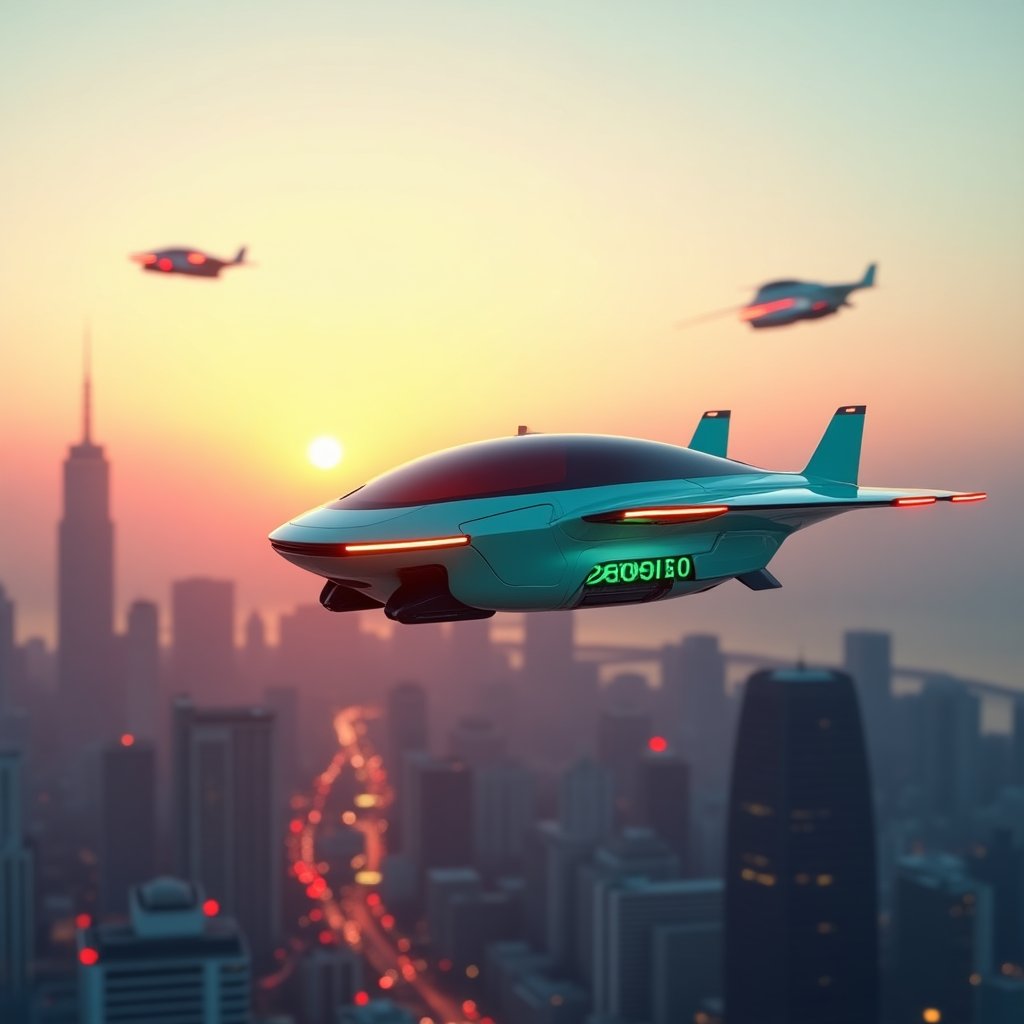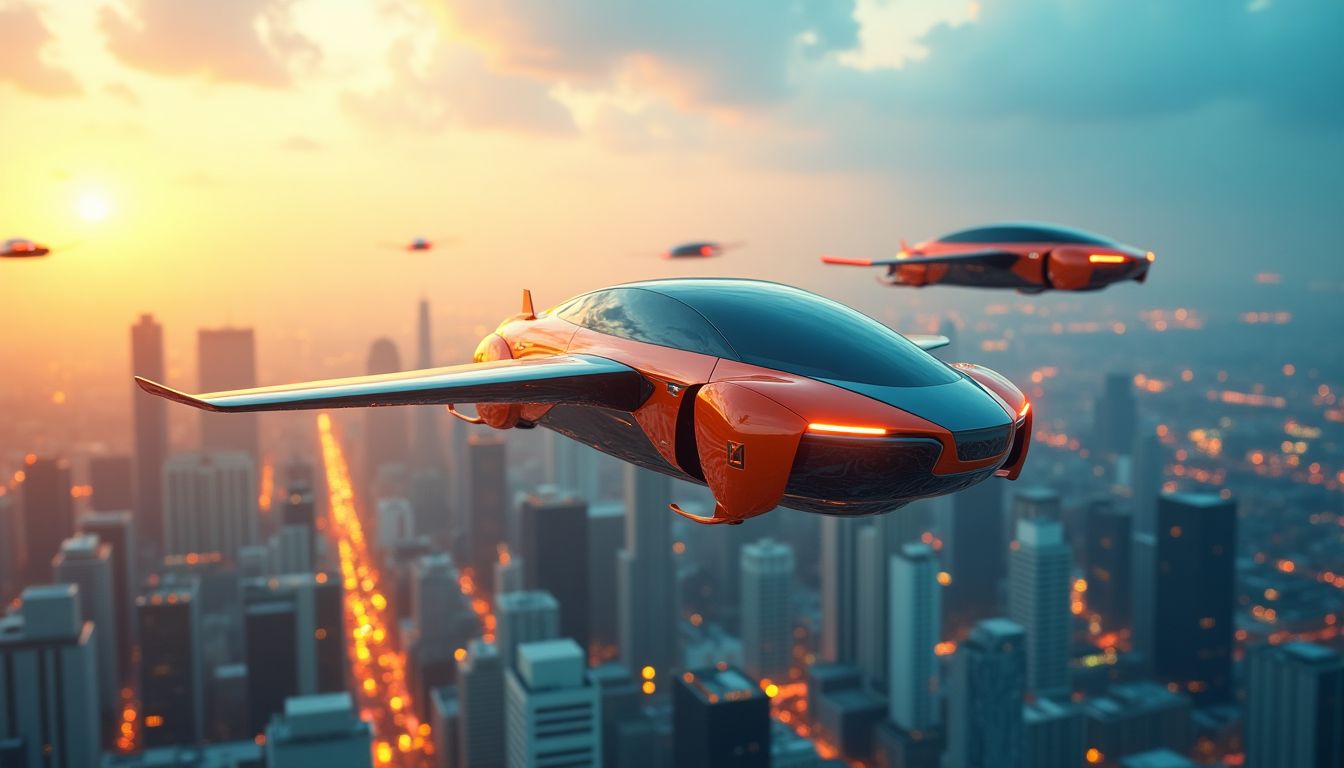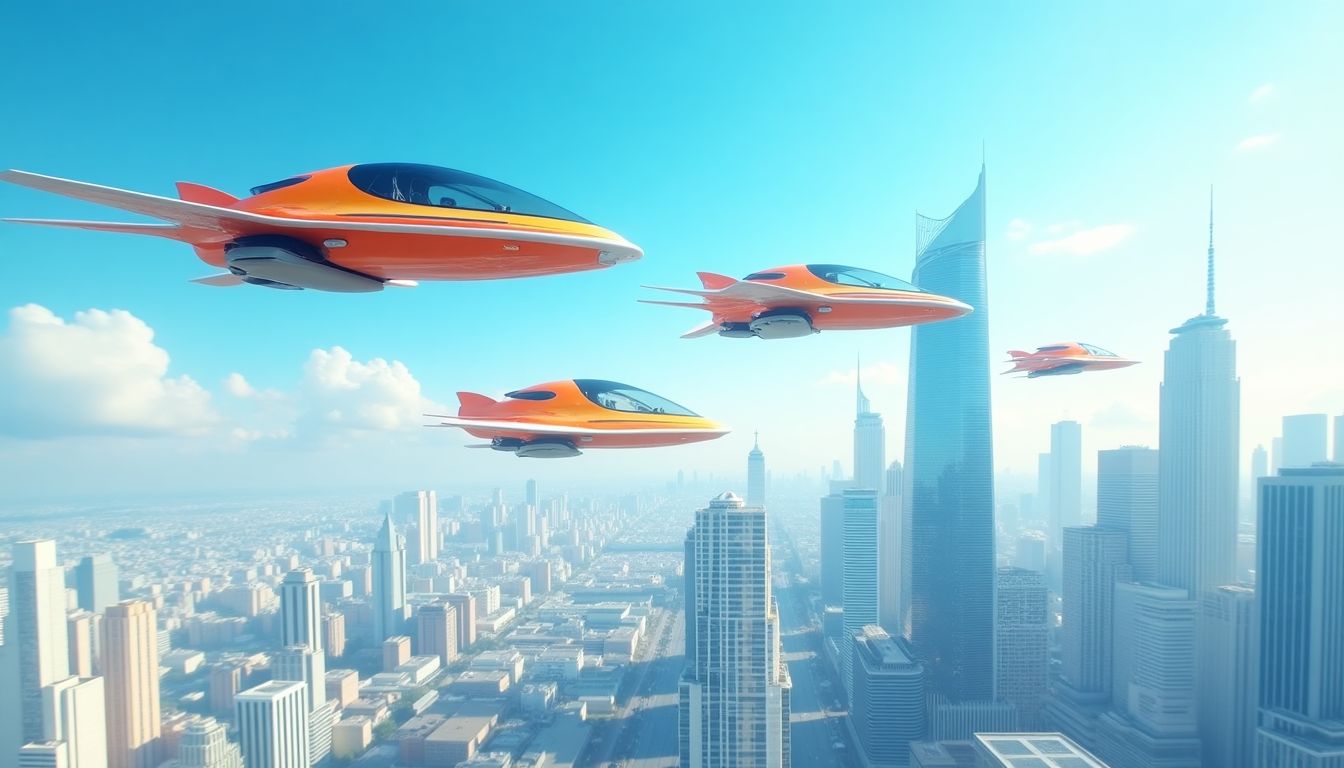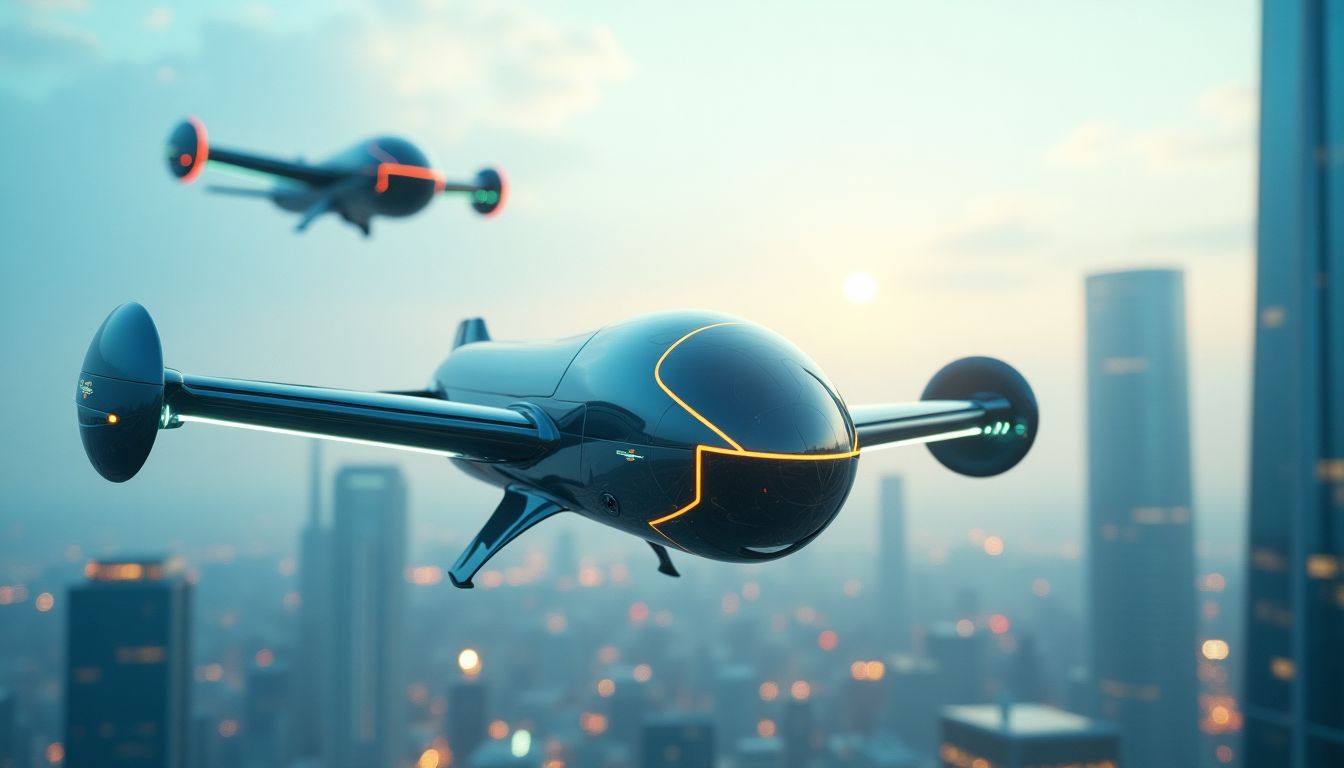What if the morning commute didn’t involve honking horns, endless traffic lights, or the occasional road rage? What if, instead, you could glide above it all, sipping your coffee while an AI-powered flying car whisked you to work? By 2030, this sci-fi dream could be your reality. The flying car revolution is no longer a far-off fantasy—it’s a tangible future being shaped by artificial intelligence (AI) and cutting-edge technology.
Visionaries like Elon Musk, who once joked that flying cars would be “noisy and blow away your neighbor’s roof,” are now cautiously optimistic. Meanwhile, researchers like Sebastian Thrun, the brains behind Google’s self-driving car project, are leading the charge in autonomous systems. Even Andrew Ng, a pioneer in AI, has hinted at the transformative potential of AI in urban mobility. Together, they’re proving that the sky isn’t the limit—it’s the next frontier.
This article dives into how AI is driving the development of autonomous flying vehicles, transforming urban mobility, and redefining the way we commute. From overcoming technical challenges to ensuring safety and scalability, AI is the linchpin that will make flying cars a viable mode of transportation. Buckle up—or should I say, strap in—because the future of commuting is about to take off.
1. The Current State of Flying Car Technology
1.1 The Evolution of Flying Cars
Flying cars have been a staple of science fiction for decades, from the Jetsons’ aerocar to Back to the Future’s DeLorean. But the real-world journey of flying cars began with early prototypes like the Aerocar in the 1950s, which looked more like a plane with detachable wings than a car. Fast forward to today, and companies like Joby Aviation, Archer Aviation, and Lilium are leading the charge with electric vertical takeoff and landing (eVTOL) vehicles. These sleek, futuristic machines are designed to take off and land like helicopters but fly like planes, all while being powered by electricity.
1.2 Technological Milestones
What’s making this possible? Advances in battery technology, lightweight materials, and propulsion systems are the backbone of modern flying cars. For instance, lithium-ion batteries have become more efficient, allowing eVTOLs to achieve longer ranges. Companies are also using carbon fiber composites to keep vehicles lightweight yet durable. But the real game-changer? AI. From optimizing vehicle design to improving performance, AI is the secret sauce that’s turning flying cars from prototypes into practical solutions.
1.3 Challenges in Development
Of course, it’s not all smooth flying. Energy efficiency and range limitations are still major hurdles. How do you keep a flying car in the air long enough to be useful without draining its battery? Noise pollution is another concern—nobody wants a swarm of flying cars buzzing over their backyard barbecue. And then there’s safety. Convincing the public to trust autonomous flying vehicles is no small feat. But with AI at the helm, these challenges are being tackled head-on, one algorithm at a time.
2. AI as the Brain of Autonomous Flying Vehicles
2.1 AI-Powered Navigation Systems
Imagine your flying car as a super-smart bird with a PhD in physics. It doesn’t just flap its wings and hope for the best—it uses AI to process real-time data from sensors, cameras, and radar to avoid obstacles and find the fastest route. Companies like Joby Aviation and Archer Aviation are already building these systems, which rely on machine learning to get better over time. Think of it as your car’s GPS, but instead of yelling at you to make a U-turn, it’s calculating the perfect flight path while dodging drones, birds, and the occasional rogue kite.
2.2 Decision-Making in Complex Environments
What happens when your flying car encounters a sudden storm or a mechanical hiccup? This is where AI shines. Advanced algorithms can handle unpredictable scenarios, like rerouting around bad weather or safely landing if something goes wrong. Researchers at MIT and Stanford University are working on AI systems that can make split-second decisions, ensuring your ride is as safe as it is futuristic. And don’t worry—these systems have fail-safes, so your car won’t just freeze mid-air like a glitchy video game.
2.3 Human-AI Interaction
Let’s face it: trusting a machine to fly you around is a big ask. That’s why companies are designing intuitive interfaces that make passengers feel in control, even when they’re not. Think voice commands like, “Take me to the office, but avoid the pigeon flock over Central Park.” AI also needs to be transparent—explaining why it’s taking a certain route or why it’s slowing down. After all, nobody wants to feel like they’re in the backseat of a robot’s science experiment.
3. Regulatory and Infrastructure Challenges
3.1 Air Traffic Management
Picture this: thousands of flying cars zipping through the skies like a scene from Blade Runner. Sounds cool, right? But without a unified air traffic control system, it could turn into chaos. AI will play a crucial role in coordinating these vehicles, ensuring they don’t crash into each other or stray into restricted airspace. Companies like NASA are already working on systems to manage low-altitude urban airspace, but it’s going to take a lot of collaboration to make this work on a global scale.
3.2 Legal and Ethical Considerations
Who’s responsible if your flying car gets into an accident? What about privacy concerns, like AI systems collecting data on your daily commute? These are the kinds of questions regulators are grappling with. Governments will need to establish safety standards, liability frameworks, and rules for data collection. It’s not just about making flying cars work—it’s about making sure they work for everyone, without turning the skies into a surveillance nightmare.
3.3 Building the Infrastructure
Flying cars need places to take off, land, and recharge. Enter vertiports—the futuristic version of bus stops. Companies like Lilium are designing these hubs to be sleek, efficient, and scalable. But integrating them into cities won’t be easy. Imagine trying to build a vertiport in downtown Manhattan without disrupting traffic or annoying the locals. It’s going to take some serious planning—and maybe a few bribes to city councils.
4. Societal and Environmental Impact
4.1 Transforming Urban Mobility
Imagine a city where rush hour traffic is a thing of the past. Flying cars promise to revolutionize urban mobility by taking vehicles off the roads and into the skies. This shift could drastically reduce traffic congestion, cutting commute times from hours to minutes. For example, a trip that currently takes 45 minutes in bumper-to-bumper traffic could be reduced to a 10-minute flight. Cities like Los Angeles and Mumbai, notorious for their traffic jams, could see a dramatic improvement in quality of life.
Flying cars also have the potential to expand access to remote and underserved areas. Rural communities, often cut off from essential services due to poor infrastructure, could benefit from faster and more reliable transportation. This could lead to better access to healthcare, education, and economic opportunities, bridging the gap between urban and rural areas.
4.2 Environmental Implications
While flying cars offer many benefits, their environmental impact is a critical consideration. The carbon footprint of flying cars will depend on the energy sources used to power them. Electric vertical takeoff and landing (eVTOL) vehicles, like those developed by Joby Aviation and Archer Aviation, are designed to be more environmentally friendly than traditional gas-powered vehicles. However, the production and disposal of batteries, as well as the energy required to charge them, still pose challenges.
Here’s a quick comparison of the environmental impact of flying cars versus traditional vehicles:
| Vehicle Type | Carbon Emissions | Energy Source |
|---|---|---|
| Gas-Powered Car | High | Fossil Fuels |
| Electric Car | Moderate | Electricity (Grid) |
| Flying Car (eVTOL) | Low to Moderate | Electricity (Renewable) |
To mitigate environmental concerns, companies are exploring the use of renewable energy sources, such as solar and wind power, to charge flying cars. Additionally, advancements in battery technology could further reduce their carbon footprint.
4.3 Economic Opportunities
The flying car revolution isn’t just about transportation—it’s also about creating new economic opportunities. The development, manufacturing, and maintenance of flying cars will generate thousands of jobs in various sectors, including engineering, software development, and urban planning. Companies like Tesla and Boeing are already investing heavily in this space, signaling the potential for significant economic growth.
New business models are also emerging, such as flying car ride-sharing services. Imagine summoning a flying car through an app, similar to how you would order an Uber or Lyft. This could democratize access to flying cars, making them available to a broader audience. Companies like Uber are already exploring this concept with their Uber Elevate initiative.
5. The Road to 2030: A Realistic Timeline
5.1 Key Milestones
The journey to a sky-bound commute by 2030 is marked by several key milestones. Here’s a breakdown of what to expect:
- 2025: Prototype testing and certification. Companies like Lilium and Volocopter are already conducting test flights, with the goal of achieving regulatory approval by 2025.
- 2027: Limited commercial deployment. Flying cars will begin operating in select cities, offering services like air taxis and emergency response.
- 2030: Full-scale adoption. Flying cars will become a common sight in urban skies, integrated into existing transportation networks.
5.2 Collaboration Between Stakeholders
Realizing this vision requires collaboration between governments, tech companies, and urban planners. Public-private partnerships will be crucial in accelerating development and overcoming regulatory hurdles. For example, the Federal Aviation Administration (FAA) in the United States is working with companies to establish safety standards and air traffic management systems for low-altitude urban airspace.
International collaboration is also essential. Organizations like the International Civil Aviation Organization (ICAO) are developing global standards to ensure the safe and efficient operation of flying cars worldwide.
5.3 Overcoming Barriers
Despite the promise of flying cars, several barriers must be addressed to ensure their widespread adoption. Cost and accessibility are significant concerns, as initial prices are expected to be high. However, as technology matures and production scales up, costs are likely to decrease, making flying cars more accessible to the general public.
Public acceptance is another critical factor. Many people are skeptical about the safety and reliability of autonomous flying vehicles. To build trust, companies must demonstrate the safety of their systems through rigorous testing and transparent communication. Public education campaigns and demonstration flights can also help alleviate concerns and foster acceptance.
In conclusion, the road to 2030 is paved with challenges, but the potential rewards are immense. By overcoming these barriers, we can usher in a new era of urban mobility, where the skies are as bustling as the streets below.
6. AI Solutions: How Would AI Tackle This Issue?
6.1 Problem Identification
The primary challenges facing the flying car revolution are navigation, safety, scalability, and energy efficiency. AI is uniquely positioned to address these issues, but it requires a multi-faceted approach. Navigation systems must process vast amounts of real-time data to avoid obstacles and optimize routes. Safety mechanisms must be fail-proof, capable of handling unpredictable scenarios like sudden weather changes or mechanical failures. Scalability demands that AI systems manage thousands of vehicles simultaneously without overloading central servers. Finally, energy efficiency is critical to ensure that flying cars are sustainable and cost-effective.
6.2 Step-by-Step AI Solutions
Navigation: Develop advanced neural networks trained on vast datasets of urban environments. Use reinforcement learning to simulate millions of flight scenarios, enabling AI to make split-second decisions. Companies like Tesla have already demonstrated the potential of AI in autonomous navigation, and their models can serve as a foundation for flying cars.
Safety: Implement AI-driven predictive maintenance systems to detect potential failures before they occur. By analyzing data from sensors and historical performance, AI can predict when components are likely to fail and schedule maintenance proactively. This approach is already being used in industries like aviation and manufacturing, with companies like GE Digital leading the way.
Scalability: Create decentralized AI systems that can manage fleets of vehicles without overloading central servers. Blockchain technology, combined with edge computing, can enable real-time data processing at the vehicle level. This ensures that each flying car can operate autonomously while still being part of a larger network. Companies like IBM are already exploring these solutions.
Energy Efficiency: Use AI to optimize flight paths and reduce energy consumption through real-time weather and traffic data analysis. AI can also manage battery usage, ensuring that vehicles operate at peak efficiency. Google’s DeepMind has already demonstrated the potential of AI in optimizing energy usage in data centers, and similar techniques can be applied to flying cars.
6.3 Scientific and Technical Foundations
To achieve these solutions, collaboration with leading research institutions is essential. The MIT Media Lab, Stanford AI Lab, and NASA Ames Research Center are already conducting groundbreaking research in AI and autonomous systems. Their work on neural networks, reinforcement learning, and predictive analytics will be critical to the success of flying cars.
6.4 Case Studies and Examples
One of the most promising examples of AI in autonomous navigation is Tesla’s Autopilot system. By leveraging data from millions of miles driven, Tesla has created an AI system capable of navigating complex environments with minimal human intervention. Similarly, Google’s DeepMind has demonstrated the potential of AI in optimizing energy usage, reducing the energy consumption of data centers by up to 40%.
6.5 Action Schedule/Roadmap
Day 1: Assemble a multidisciplinary team of AI engineers, aerospace experts, and urban planners. Key personnel could include Andrew Ng (AI), Sebastian Thrun (autonomous systems), and Elon Musk (visionary leadership).
Day 2: Secure funding from venture capital firms and government grants. Potential investors include Andreessen Horowitz and Y Combinator.
Week 1: Begin prototyping AI algorithms for navigation and obstacle detection. Collaborate with MIT Media Lab and Stanford AI Lab for R&D support.
Week 2: Partner with universities for R&D collaboration. Establish partnerships with Caltech and Carnegie Mellon University.
Month 1: Conduct initial simulations of urban airspace. Use data from cities like San Francisco and New York City to create realistic models.
Month 2: Test AI systems in controlled environments. Use facilities like NASA Ames Research Center for initial testing.
Year 1: Launch pilot programs in select cities. Begin with cities that have favorable regulatory environments, such as Dubai and Singapore.
Year 1.5: Scale up production of eVTOL vehicles. Partner with manufacturers like Joby Aviation and Archer Aviation.
Year 2: Achieve regulatory approval for commercial operations. Work with agencies like the FAA and EASA to establish safety standards.
The Sky’s the Limit: A Future Redefined by AI and Flying Cars
The flying car revolution is not just a technological leap—it’s a paradigm shift in how we think about transportation. AI is the driving force behind this transformation, enabling vehicles to navigate complex environments, ensure safety, and operate at scale. By 2030, the skies could be filled with autonomous flying cars, reducing congestion, cutting commute times, and opening up new possibilities for urban living.
However, realizing this vision requires collaboration between governments, industries, and communities. It demands innovation, investment, and a commitment to overcoming the challenges ahead. The future of commuting is not just about getting from point A to point B—it’s about reimagining the way we move through the world.
Imagine a world where rush hour traffic is a relic of the past, replaced by a seamless network of autonomous flying vehicles gliding through the skies. This is not just a dream—it’s a future that’s within our grasp, thanks to the power of AI. The question is, are we ready to take the leap?
What do you think about the future of flying cars? Are you excited about the possibilities, or do you have concerns about safety and regulation? Share your thoughts in the comments below, and don’t forget to subscribe to our newsletter for more insights into the future of technology. Become a permanent resident of iNthacity: the "Shining City on the Web" and join the conversation!
Frequently Asked Questions (FAQ)
1. Are flying cars safe?
Flying cars are designed with safety as the top priority. Advanced AI systems, like those developed by Tesla Autopilot, ensure real-time obstacle detection and navigation. Additionally, companies like Joby Aviation and Archer Aviation are rigorously testing their vehicles to meet strict safety standards. Fail-safe mechanisms and predictive maintenance powered by AI further reduce risks.
2. How much will flying cars cost?
Initially, flying cars will be expensive, with prices likely comparable to luxury vehicles. However, as technology advances and production scales up—similar to how Tesla reduced the cost of electric cars—prices are expected to drop. Companies like Lilium are already working on affordable models for mass adoption.
3. Will flying cars reduce traffic congestion?
Absolutely! By taking vehicles off the roads and into the skies, flying cars can significantly reduce ground-level traffic. Cities like Dubai are already exploring this concept to ease congestion. AI-powered air traffic management systems will ensure smooth coordination, making urban commutes faster and more efficient.
4. What about the environmental impact?
Flying cars will have a carbon footprint, but advancements in battery technology and renewable energy integration can help mitigate this. For example, Tesla and Panasonic are developing more efficient batteries, while companies like Joby Aviation are focusing on electric propulsion systems to minimize emissions.
5. When can we expect flying cars to be widely available?
Limited commercial deployment is expected by 2027, with full-scale adoption by 2030. Companies like Archer Aviation and Lilium are on track to achieve this timeline, pending regulatory approvals and public acceptance.
6. Who is leading the development of flying cars?
Several companies and institutions are at the forefront of this revolution:
- Joby Aviation: A pioneer in electric vertical takeoff and landing (eVTOL) technology.
- Archer Aviation: Focused on urban air mobility solutions.
- Lilium: Developing high-speed, electric flying taxis.
- Tesla: Known for its AI and autonomous driving systems, which could play a role in flying cars.
7. What are the biggest challenges facing flying cars?
The main challenges include:
- Regulatory Hurdles: Governments need to establish air traffic rules and safety standards.
- Infrastructure: Building vertiports and charging stations in urban areas.
- Public Acceptance: Overcoming skepticism and fear of new technology.
8. How will AI improve flying car technology?
AI is the backbone of flying cars, enabling:
- Navigation: Real-time obstacle detection and route optimization.
- Safety: Predictive maintenance and fail-safe mechanisms.
- Efficiency: Optimizing energy usage and flight paths.
Institutions like MIT and Stanford University are conducting cutting-edge research to enhance these AI capabilities.
9. Will flying cars be autonomous?
Yes, most flying cars will be autonomous, relying on AI systems similar to those used in self-driving cars. Companies like Tesla and Waymo are leading the way in autonomous technology, which will be adapted for aerial vehicles.
10. How will flying cars impact jobs?
Flying cars will create new job opportunities in:
- Manufacturing: Building and assembling vehicles.
- Maintenance: Ensuring the safety and functionality of fleets.
- Software Development: Designing AI systems and navigation software.
This shift could also lead to the growth of new industries, such as flying car ride-sharing services.
11. What cities are most likely to adopt flying cars first?
Cities with high traffic congestion and advanced infrastructure, such as:
- Dubai: Already testing flying taxis.
- Los Angeles: A hub for tech innovation.
- Singapore: Known for its smart city initiatives.
12. Can I own a flying car, or will they be ride-sharing only?
Initially, flying cars will likely be available through ride-sharing services, similar to how Uber operates today. However, as technology becomes more affordable, personal ownership could become a reality, just like with traditional cars.
13. What happens if a flying car malfunctions mid-air?
Flying cars are equipped with multiple fail-safe mechanisms, including:
- Parachutes: For emergency landings.
- Backup Systems: Redundant propulsion and navigation systems.
- AI Monitoring: Predictive maintenance to detect issues before they occur.
Companies like Joby Aviation are rigorously testing these systems to ensure passenger safety.
14. How will flying cars handle bad weather?
AI systems will analyze real-time weather data to adjust flight paths or delay trips if necessary. Advanced sensors and radar, similar to those used by NASA, will ensure safe navigation even in challenging conditions.
15. Will flying cars be noisy?
Modern eVTOL vehicles are designed to be quieter than helicopters, thanks to electric propulsion systems. Companies like Joby Aviation are working to minimize noise pollution, making flying cars more suitable for urban environments.
16. How will flying cars affect real estate?
Flying cars could make remote areas more accessible, potentially increasing property values in previously underserved regions. Cities might also see a shift in urban planning, with vertiports becoming a new architectural feature.
17. What role will governments play in the flying car revolution?
Governments will need to:
- Regulate: Establish safety standards and air traffic rules.
- Invest: Fund infrastructure like vertiports and charging stations.
- Educate: Build public trust through awareness campaigns.
Countries like the United States and United Kingdom are already working on frameworks to support this transition.
18. Can flying cars be hacked?
Like any connected technology, flying cars could be vulnerable to hacking. However, companies are investing heavily in cybersecurity measures, similar to those used by Palo Alto Networks, to protect against such threats.
19. Will flying cars be accessible to everyone?
Initially, flying cars will likely be a premium service, but as technology becomes more affordable, they could become accessible to a broader audience. Ride-sharing models, like those pioneered by Uber, will help democratize access.
20. What’s the biggest misconception about flying cars?
Many people think flying cars are just a futuristic fantasy, but the reality is that they are already being tested and developed by leading companies and institutions. The future of urban mobility is closer than you think!
Wait! There's more...check out our gripping short story that continues the journey: The Nimbus Horizon
Disclaimer: This article may contain affiliate links. If you click on these links and make a purchase, we may receive a commission at no additional cost to you. Our recommendations and reviews are always independent and objective, aiming to provide you with the best information and resources.
Get Exclusive Stories, Photos, Art & Offers - Subscribe Today!





























1 comment